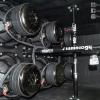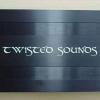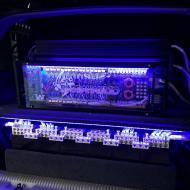Leaderboard
Popular Content
Showing content with the highest reputation on 12/24/2010 in all areas
-
2 pointsI also own an L7. For the purpose it was acquired for it is a great driver. All of the anti-hype is a joke as is the implications form the video that it is the end of all other designs (no I didn't watch it). Everything is a balance. For my app, it was box size and output capability that made it win. Lots of limitations on a boat and it works perfectly and sounds great for what it was designed to do. Are there better drivers out there? Sure. Are there better drivers for the application that I am using it for? Perhaps, but not many. All based on the constraints of the install. Same thing when people bash the possibility of any 6x9 sounding good. It IS possible. Atm there aren't any on the market that I want, but it isn't at all because of the shape. As for why no one else builds square subs? Its all tooling cost and balancing the goals of their drivers. No such thing as custom tooling for small production runs and keeping affordability.
-
1 pointClose to half the vibration damping/noise mitigation threads on other forums are debates about using asphalt based materials as a vibration damper. I’ve spent way too much time during the last 5 years typing and re-typing responses to these questions. Let’s keep it in one place to reduce litter and redundancy. This topic was my introduction to aftermarket “sound deadening”. I had a noisy car, wanted to quiet it down and started to do research. This was 2005. Several respected “authorities” were vocal advocates for asphalt. Part of this came from the belief that products like Dynamat Xtreme were part of a conspiracy to fleece consumers. Part of it was the often repeated “fact” that roofing materials and vibration dampers sold specifically for aftermarket automotive use were exactly the same thing. One cost pennies per ft² and the other dollars so it was worth investigating. Some of you may remember that Sound Deadener Showdown used to be a testing and review site. Since I wasn’t able to find any conclusive answers on the forums, I decided to buy small quantities of every product I could. Two things were immediately apparent: Nobody had ever had their hands on all of these products at the same time or they would have seen the obvious differences. The people claiming that Dynamat Xtreme and roofing materials were exactly the same thing didn’t know what they were talking about. I discovered a few other things very quickly. Many sellers were making outrageous claims. Some were wildly overstating obvious physical characteristics like thickness and mass/area. Others were either claiming outright that their asphalt products were butyl or were using intentionally deceptive descriptions like “rubberized compound” to describe their adhesive layer. Nobody seemed to be drawing the right conclusion from sellers’ attempts to hide the fact that they were selling asphalt. For several years the argument was about durability. Asphalt had an unhappy tendency to melt or fall off. At the time, there were no reports of butyl adhesive failure – that had to wait a few years until one seller decided to re-purpose some low quality butyl roofing material. I spent a lot of time trying to figure out why this was happening. All of these materials are asphalt with some sort of rubber added to increase heat tolerance. The generally accepted melting point for these compounds is 180°F. That seemed high enough for use in a vehicle, so what was going on? Our perception of the heat these products are subjected to was wrong. We thought in terms of air temperature inside the vehicle, maybe 140°F-150°F? It turns out things are very different at the sheet metal. Park a car in the sun during the summer, south of the Mason-Dixon line and you can easily get to 180°F+. That explains immediate failures in hot climates. An insidious part of this problem is that many failures were reported during the second or third summer, many in fairly mild regions. The explanation was pretty simple. The rubber added to asphalt deteriorates over time when exposed to temperatures much lower than those required to melt the fresh material. As the rubber deteriorates, the melting temperature drops. Suddenly it doesn’t take much heat anymore. The durability question has been answered to my satisfaction. Many high profile asphalt devotees, including some who went to almost insane extremes to install the material “properly” have had their installations fail over the years. A few of the brave ones have come forward and made their results public. The pennies vs. dollars argument still nags. What if you plan to junk your vehicle after a few years (worse, plan to trade it in and don’t care what problem you are passing on)? Is asphalt a reasonable choice when durability isn’t a factor? Nope. There are two main reasons people believe they can substitute asphalt roofing materials for CLDs: They look alike – shiny on one side, black and gooey on the other. They don’t understand how a constrained layer vibration damper works. See: Caddy Shack, swimming pool scene for all you need to know about point 1. Point 2 needs more consideration. I used to believe that vibration dampers work by adding mass to a panel and lowering its resonant frequency below the audible range. This is completely wrong. They work through a fairly complex sequence of events that occur in the adhesive layer and between the adhesive layer and the constraining layer and substrate. I won’t go into the details here, please see: Vibration Damping By Ahid D. Nashif, David I. G. Jones, John Phillips Henderson The important point is that everything depends on the material property viscoelasticity. Basically this describes something that can be deformed and will then return to its original shape more slowly than it was deformed. The strains created during these events account for the conversion of vibration to heat that we’ve all heard about. Butyl adhesives formulated for vibration damping are viscoelastic. Asphalt isn’t – it doesn’t need to be to seal a roof. Asphalt adds mass to a panel. It may stiffen the panel, but since stiffening raises resonant frequency, the two mechanisms are offsetting and reduce effectiveness even further. Those who claim to have used it and had good results aren’t giving you the full picture. These claims can be better stated as: I used asphalt. It was better than nothing. I haven’t used a proper purpose designed vibration damper so I have no basis for comparison. It hasn’t failed yet. Sometimes the endorsement is explicitly stated: I used asphalt and it hasn’t fallen off. Not falling off is a pathetically low standard of performance. Testing I’ve done has convinced me that it takes between 6 and 10 times as much asphalt to achieve something approaching the same result you will get with a real vibration damper. This puts the pennies/dollars question on its head. Add the durability concerns and the huge amount of extra work required and the answer is pretty obvious. I’m sure some will want to argue the points I’ve made here. If that’s you, please stay away from “I used it and it worked for me”. That’s how we got into trouble in the first place and doesn’t make any more sense than concluding that cigarettes are good for you because your grandfather smoked a pack a day and lived to be 90. If you want to go there, please show us some evidence.
-
1 pointI ran across this video today, and it made me wonder if this guy was talking out of his ass or not. What he's saying does make sense to me, talking about a square has more surface area to push more air out then a round woofer would. But if that was the case, then how come almost no manufacturer on this site even offers a square in any of their lineups? This part didn't make sense to me, because from what this guy is saying, everybody would be designing square woofers right?
-
1 pointAbout the only "problem" with a square subwoofer is the increased stress at the corners of the surround and stress on the cone. Though all you have to do is physically look at one of Kicker's drivers to see what they did to combat these problems. Within the bandwidth of the driver, these issues probably have more do to with longevity of the driver than actual audibility. The people making comments about how bad square drivers sound need to step back and realize that it had nothing at all to do with the shape of the cone. First and foremost it comes down to enclosure selection, installation and tuning. Second, the driver's design in terms of mechanical and electrical parameters and performance might have not aligned with their goals.....it wouldn't have mattered if the cone was square or round, the driver was simply not for them. More companies aren't using them for the simple reason Sean mentioned. The cost of tooling the parts is probably not worth the benefit for most non-mainstream companies such as Fi, etc. You have to custom design and tool a cone, surround and basket at minimum. That's not cheap.
-
1 point15 ft or so is a good estimate. Better to have extra than to run out. There are plenty of threads on here that show detailed pics with subtitles. So sit back and use the search function and you should be able to find some good information.
-
1 pointI was pretty damn excited to wire it up… A big hell yes goes out to Fi Car Audio for making great woofers including this new BtL, I know it was a pain to make this sub for me, but I appreciate it. Then five minutes later: The most anxious part in the build… I had measured the side-to-side distance to be just capable of clearing the woofer. Lets just say a piece of paper can slide in on one side but not the other Been waiting to predrill the woofer mounting holes so I can carpet the visible portions of this side. The fact that the baffle was so closely measured side-to-side meant the woofer was automatically lined up in that regard. I cut the mounting hole exactly so that the outer edge of the woofer would be a half inch off the floor of the trunk, so once I shimmed the woofer up with a piece of .5” MDF it was just about lifting the magnet into place with some lumber I had laying around, which in turn brought the woofer flush. I did a poor job leveling the magnet, I guess its hard while looking upside down and backwards at it but its fine. The hole was cut 14 and 3/16 inches, and the woofer sits in there perfectly inverted. With that magnet, how can I not invert it?? You may have seen this picture already, but that’s the only one I snapped before I put the back seat in. I have a few things to tweak in there in the coming weeks, so I will probably wire that up in a prettier fashion. Honestly the woofer has itty bitty clamp terminals, real tough to get full copper contact with one 8ga input let alone two. Its in, its tight, im not touching it for now Putting my back seat in was a real pain… Its so closely fitted again that the back of the seat actually flexes a bit against the box when I bolt it down, but I wanted that so the seat sits in place tightly and doesn’t get pummeled around by the BtL. I used some adhesive rubber strips, big chunks of closed cell foam, and some carpeted pieces of MDF to keep an airtight seal between the woofer’s “chamber” and the seat. I doubt the seat is rigid enough to allow for a 6th order effect from the seat blow through, but who knows. I don’t live in the most crime filled area, but around here if somebody peeked in and saw a monster 15” BtL they would probably steal my car. The woofer was bolted in with Torx screws and my father-in-laws 50lb torque drill, into a half inch of fiberglass. Nobody could budge those screws with any cordless drill, let alone a screw driver And that’s how it has to stay for now, at least until after xmas. I left enough room for mounting a second monoblock, I hope to upgrade to a pair of Rockford bdCPs. The box sounds good so far as it should, very much a similar overall design scheme compared to my previous BtL enclosure (visible next to my name over there <<<<), time will tell if it really bangs like the gen 2. Door panels are also soon to come, though my highs are well suited to the current configuration, I just want a little more flare than the stealth look this car has now. Thanks for reading, feel free to post comments. Enjoy your holidays, relax like my dog here, just toasting in front of the wood stove
-
1 pointHey guys.... I been talkin to him... it's different than you're realizing... Right now, the only wires connected to the amp ARE: BATT+, Ground, speaker wires AND RCA's. The wire from the HU is no longer connected to the amps at any point in the line. What happens is that when he connects, with a short 4" lead, the remote terminal of the master, to the slave, the master powers on. I have seen these kinds of problems in motor control centers when a relay or contactor's neutral/ground gets a bad connection. It can cause a strange feedback like situation, for reasons unknown to me that causes others to stay pulled in, or not work, and otherwise wreak complete havoc in the panel on anything that shares the same set of power and ground connections. I believe there's a problem with a remote relay inside one of the amps.
-
1 pointIn terms of square versus round, you will not be able to discern an audible difference between a square or cone driver. People who tell you otherwise are full of shit. The square driver will have some different harmonics and non-linearity, but by the time you hear these, you will hearing issues with a cone shaped driver as well. The only reason the L7s have a reputation for not sounding good is the same reason ca.com's forum is still going. The world is world is full of idiots.
-
1 pointWell, ~25% per cone could be a differnce once you start to multiply them. Sure it could all add up, but for the average consumer, having a 10" square driver vs a 10" circular driver, the difference would be less then 25% and likely not audible, tuning the enclosure / raising net volume would be more noticeable And were not even talking about the actual sd of the driver, this number varies from model to model. And by your standards of gaining more output the driver could just have more xmax and thus more displacement. But theirs a limit to everything and a point to where it's not worth it, everything has it's trade-offs
-
1 pointYeah, I see your point, but then that would be more money for the consumer, If the buyer could lets say only fit a 10, then basicly, from what your saying, and what the video is saying, the buyer would be more satisfied if he/she bought a square woofer? I know this can't be true because its the overall box, amp, aplication, and the overall subwoofer design, etc etc etc. But, I'm wondering, how come the manufacturers that we love here on SSA, don't produce square woofers. But I think you answered my question by talking about the linear and distortation. I guess that would have to be one the disadvantage of the square design. I wonder if anyone has taken the time to try it out though, like put as much effort into the square design, as they do with the round ones. (besides Kicker) Because maybe if FI, or SA, or SSA or whomever could take the time to develop a proper square woofer design, that would take care of those few flaws in the square design, then maybe they would produce a subwoofer that would have more output without haveing to get a bigger driver? IDK, just wondering. It's not worth it, the disadvantages outweigh it's advantage. The cone area increase isn't dramatic. And it may be very costly for companies like Fi, Sundown, SSA to try and manufacture square cones. As for costing more for the consumer, eh your not talking about a big price jump considering theirs a $20 difference between a 12" and 18" xcon.
-
1 point
-
0 pointscan you sell me one Bangin'??? I need an upgrade... lulz... for real though, that is weird.. power transfer from the other amp none of which have the remote 12v connected to battery... Are all the other wires still connected? Something shorting? I'm just thinking in terms of electricity and possibly something is triggering power from the batteries??? Maybe God wants you to get rid of your "slave" amp because having a slave is wrong???
-
0 pointsYou didn't read anything I wrote, did you. Your wire could be shorting on something between your radio and amps, so just running a quick little wire from radio to amp could see if this is true. It is also "ignorant" that someone with as many amps/woofer/speakers as you have can't figure out a simple remote wire issue.
-
0 pointsLarger cone area, less efficient, and corners help cause distortion, but can have slightly higher output at low frequencies and can be better in limited space. Google ftw. "Being as how sound waves travel radially any other shape than round will be both less efficient and distorted."
-
-1 pointsI did not really understand your box !!! :roflmao:But if it sounds good and you like it : it's cool ! Great work.
-
-2 pointsThis is a simply ridiculous thread. You know where the issues is, it's between the Head-unit and the amps. Do not post again until you do this ~~~ Take your radio out of your dash, disconnect current remote wire/wires. Connect a new one and go straight to amps without running under anything or hiding it, just straight to amps and see it it works right.~~~









.jpg.ea8ac89a2ec7f49de0b9e4027c74f515.thumb.jpg.dc61d2e06476e189721027d6a6eb6027.jpg)

